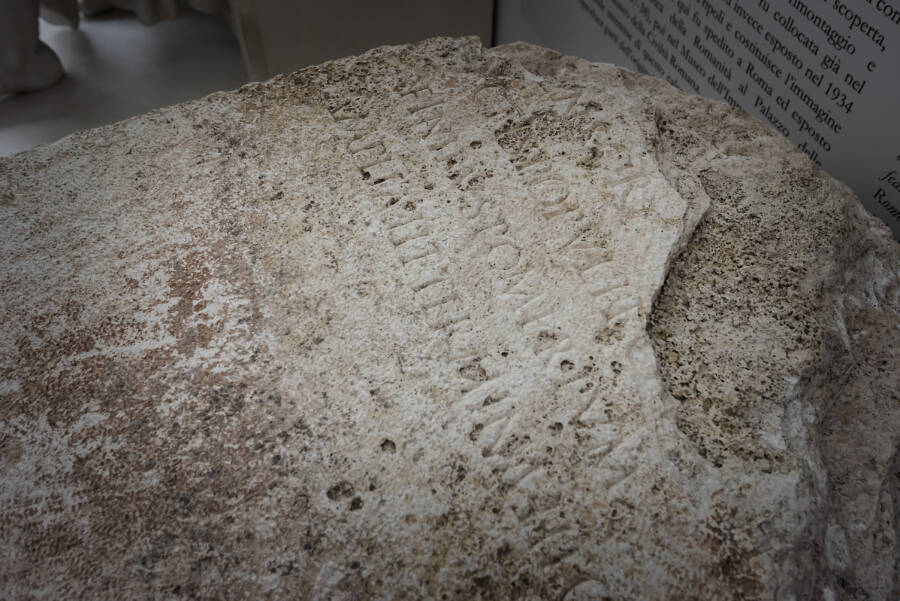One of only 10 of its kind ever found, this ancient stone marked the spiritual, military, and political boundary of the ancient city of Rome.

Stefano Montesi/Corbis/Getty ImagesThe ancient stone at the Ara Pacis Museum on July 16, 2021, in Rome, Italy.
Workers performing an excavation for the rerouting of a sewer system just discovered a rare stone marker that marked the city limits of ancient Rome.
The discovery was made on June 17 and announced on July 16 at an unveiling at the Ara Pacis museum, near the site where the ancient slab was discovered.
Archaeologists have spent the last few weeks studying the stone in detail, according to Associated Press. They have dated it to the reign of Emperor Claudius in 49 A.D. and discovered that the slab served as a political and military marker that identified where Rome’s city limits began.
The travertine limestone rock was formerly part of the “pomerium,” a religious boundary on the outskirts of Rome that its people considered sacred. It was forbidden to farm, live, or even build in the pomerium. And it was also illegal to carry weapons past the city limits into the capital.

Stefano Montesi/Corbis/Getty ImagesThe inscription on the stone firmly dated it to 49 A.D., when Emperor Claudius expanded the city limits.
Although this isn’t the first time that seemingly routine construction work has led to the discovery of historic artifacts — just a year ago ancient Roman paving stones laid between 27 and 25 B.C. were unearthed as workers repaired sinkhole damage in the capital — this find is unique for its rarity.
The stone, called a “cippus,” is one of only 10 such pomerium markers ever unearthed in Rome, the last of which was discovered 100 years ago.
“The founding act of the city of Rome starts from the realization of this pomerium,” said Claudio Parisi Presicce, director of the Archaeological Museums of Rome.
Workers encounters it as they were attempting to reroute a sewer that ran directly under the recently-restored mausoleum of Emperor Augustus on the Via del Corso in the middle of Rome’s historic center.
For Rome Mayor Virginia Raggi, the discovery of this consecrated object was nothing short of astonishing, and it was a reminder of how much history lay right beneath their feet.
“Rome never ceases to amaze and always shows off its new treasures,” she said.

Flickr/Clement SerratVia del Corso in Rome, Italy.
Researchers used the stone’s inscriptions to date it back to Claudius and also analyzed the stone itself. The white-colored travertine was common for markers such as this, and was used prominently in the construction of civic buildings as Claudius oversaw an expanding empire.
Born in 10 B.C., Claudius reportedly had a lifelong limp and regularly foamed at the mouth. While many modern-day experts believe he suffered from cerebral palsy or Tourette’s syndrome, his mother deemed him “a monstrosity of a human being.” However, he wound up the only surviving heir of Augustus — and ruled from 41 to 54 A.D.
While he had the support of soldiers, the Senate not only disliked him but was involved in numerous shadowy plots on his life. According to PBS, Claudius nonetheless managed to conquer Britain, which became the greatest expansion of the empire since the reign of Augustus — a victory not even Caesar had managed.
In the end, neither foreign threat nor battlefield encounter proved to be Claudius’ undoing. Instead, it was his own wife, Agrippina. Determined to make her son, Nero, the emperor of Rome, she poisoned Claudius with a toxic mushroom. When it failed to kill him, she used his own doctor to poison him under the guise of care.

Wikimedia CommonsProclaiming Claudius Emperor (1867) by Lawrence Alma-Tadema.
While we know that the rare stone was built and erected five years before Claudius died during the expansion of Rome’s pomerium, further details are sparse. What remains clear is that this item served a sacred, political purpose — and reinforced how seriously Ancient Romans took their territory.
The stone will be displayed at the Ara Pacis museum until the mausoleum of Emperor Augustus concludes its restorations and officially reopens next year.
After reading about the rare stone discovered in Rome that outlined the city’s ancient limits, learn 33 Ancient Rome facts that will change the way you see history. Then, read about Emperor Caligula — Ancient Rome’s most infamous ruler.





